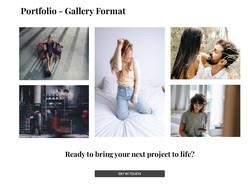
Personal Portfolio
Design your personal portfolio with free Google Sites templates. Visual, customizable layouts ideal for artists, writers, developers, and creative professionals.

Design your personal portfolio with free Google Sites templates. Visual, customizable layouts ideal for artists, writers, developers, and creative professionals.
A personal branding website is more than a digital résumé — it’s your story, values, and voice expressed through a structured, accessible format. Whether you’re a designer, consultant, creator, or job seeker, a portfolio website helps control how you’re perceived and discovered.
This guide outlines how to build a personal brand site from scratch using free tools, even without prior web experience. It focuses on layout logic, content flow, and how simple template structures can elevate credibility.
Why it matters: Visitors should instantly grasp your core identity. Are you a strategist? A creative? A problem-solver?
Start with a concise statement that combines role, niche, and edge:
“UX designer blending behavioral psychology with interface systems to simplify decision-making for SaaS products.”
This sets context while being distinct and searchable.
Why it matters: People visit personal sites to answer questions:
• Who are you?
• What have you done?
• How can they contact you?
Use clear navigation with sections like “About,” “Work,” “Testimonials,” and “Contact.” Highlight outcomes, not just job titles — what changed because of your involvement.
Why it matters: Branding isn’t just visuals — it’s experience.
Google Sites offers a flexible grid, drag-and-drop sections, and mobile responsiveness by default. Use this to guide readers visually without distractions. For example:
• Use grid layouts for portfolio pieces
• Embed YouTube or Drive for live previews
• Link to résumé or Calendly for action steps
Why it matters: Reputation grows through trust signals.
Instead of listing a title, use case-driven summaries:
“Redesigned onboarding flow for edtech platform — improved user activation by 33% in 2 months.”
Each entry should suggest expertise + impact + context.
Why it matters: A personal site should find its audience.
Use headings that match search terms (“Graphic Designer Portfolio,” “Freelance Copywriter in Berlin”). Include alt text on images. Link your site from LinkedIn and other profiles. A well-structured site is easier to rank.
A personal branding website isn’t just a design exercise. It’s a positioning tool — one that signals credibility, communicates skills, and invites connection. A clean, well-structured template enables that clarity from the start.